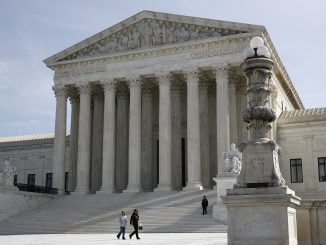
MADISON, Wis. — Wisconsin’s Supreme Court will flip from majority conservative to liberal control in August and Democrats have high hopes the change will lead to the state’s abortion ban being overturned and its maps redrawn to weaken GOP control of the Legislature and congressional districts.
Democrats in the perennial battleground state focused on abortion to elect a liberal majority to the court for the first time in 15 years. The Democratic Party spent $8 million to tilt the court’s 4-3 conservative majority by one seat with the election of Janet Protasiewicz, who spoke in favor of abortion rights and against the Republican-drawn map in a campaign. Her April victory broke national spending records for a state Supreme Court race.
Still, there are no guarantees. Republicans were angered when a conservative candidate they backed in 2019 turned out to sometimes side with liberal justices.
While the court is widely expected to weigh in on abortion and redistricting, liberals also are talking about bringing new challenges to school choice, voter ID, the 12-year-old law that effectively ended collective bargaining for most public workers and other laws backed by Republicans.
“When you don’t know the extent of the battle you may have to fight, it’s concerning,” said attorney Rick Esenberg, president of the conservative Wisconsin Institute for Law & Liberty. “It’s very concerning.”
Some issues could take years to reach the court, said liberal attorney Lester Pines, who like Esenberg has argued numerous times before the state Supreme Court. Unlike under the conservative majority, Pines said the new liberal court will be unlikely to rule on cases before lower courts have heard them.
“They’re not going to do it,” Pines said.
There is already a pending case challenging Wisconsin’s pre-Civil War era abortion ban, and a circuit court judge ruled earlier this month that it can proceed, while also calling into question whether the law actually bans abortions.
The case is expected to reach the Supreme Court within months. Protasiewicz all but promised to overturn the ban by repeatedly speaking out for abortion rights, winning support from Planned Parenthood and others.
“When you’re a politician and you’re perceived by the voters as making a promise, and you don’t keep it, they get angry,” Esenberg said.
There is no current redistricting lawsuit, but Democrats or their allies are expected to file a new challenge this summer seeking new districts before the 2024 election.
The state Supreme Court upheld Republican-drawn maps in 2022. Those maps, widely regarded as among the most gerrymandered in the country, have helped Republicans increase their hold on the Legislature to near supermajority levels, even as Democrats have won statewide elections, including Tony Evers as governor in 2018 and 2022 and Joe Biden in 2020.
Protasizewicz declared those maps to be “rigged” and said during the campaign they should be given another look. Democrats also hope for new congressional maps improving their chances in the state’s two most competitive House districts, held by Republicans.
“What we want to see is maps that are fair and that represent the will of the people and the actual make up of their state,” Democratic strategist Melissa Baldauff said.
Four of the past six presidential elections in Wisconsin have been decided by less than a percentage point. The outgoing conservative court came within one vote of overturning Biden’s win in 2020. The new court will be in control to hear any challenges leading up to the election and in the months after.
A national Democratic law firm filed a lawsuit on Thursday seeking to undo a Wisconsin Supreme Court ruling last year banning absentee ballot drop boxes. The case could make its way to the state high court before the 2024 presidential election.
Other sticky issues that have garnered bipartisan criticism, including powers of the governor, also could come before the new court.
Evers surprised many with a veto this year putting in place a school spending increase for 400 years. Republicans said a challenge was likely.
In 2021, the court struck down three of Evers’ previous partial vetoes but failed to give clear guidance on what is allowed.
A Wisconsin governor’s veto power is expansive and used by Republicans and Democrats, but the new court could weigh in on whether it should be scaled back. Esenberg, who brought the previous case challenging Evers’ veto powers, said he expected another legal challenge in light of the 400-year veto.


